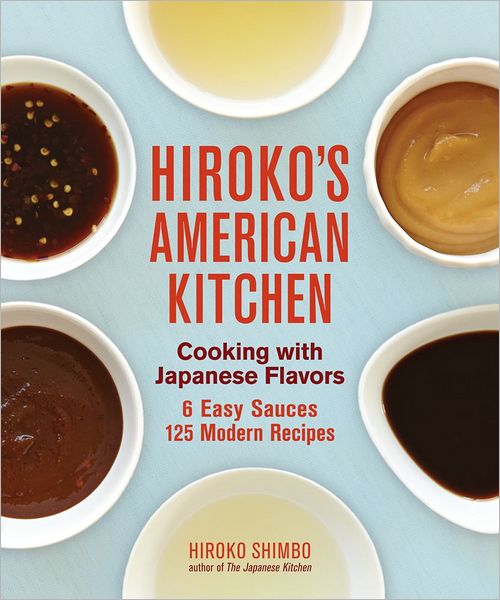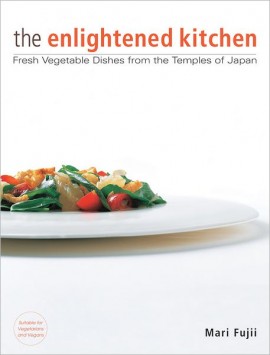Hiroko's American Kitchen Cooking with Japanese Flavors
You love Japanese food. You enjoy it at restaurants whenever you can. But what you really want to do is to prepare it in your own kitchen. That’s easy…
You love Japanese food. You enjoy it at restaurants whenever you can. But what you really want to do is to prepare it in your own kitchen. That’s easy using Hiroko Shimbo’s classic books, The Japanese Kitchen and The Sushi Experience. But wait: Can you find the ingredients? Can you take the time to prepare it? Your friends, family, significant other—will they relish these “foreign” dishes the way you do?
Hiroko’s American Kitchen provides answers to all of those questions. Here there are 125 new recipes that highlight the best of Japanese cuisine, but in new, simpler ways. The recipes are organized in chapters, each using one of two stocks or four sauces. By preparing and storing these easily made items, with a minimum of time and fuss you can enjoy a wide variety of delicious dishes every day. These are recipes that use the ingredients that you have or can easily purchase, and are prepared and served in dishes that are familiar to American tastes and dining habits. In other words, delicious, healthful Japanese dishes designed for the American kitchen and the American diner. The recipes include Corn and Ginger Rice with Shoyu and Butter, Quick Gingered Pork Burger, Chunky Potato and Leek Soup with Miso, Avocado and Yellowfin Tuna Salad, and Curried Miso Peanuts. This is not fusion or confusion cooking, but a respectful extension of traditional Japanese cooking to bring to your table.
Hiroko Shimbo is an authority on Japanese cuisine, with worldwide recognition. A chef-consultant for food companies and restaurants, Hiroko is also a trained sushi chef, author, media performer, and chef-instructor. Hiroko operates Hiroko’s Kitchen, LLC, a consulting company, in New York City. Hiroko’s award-winning, best-selling book, The Japanese Kitchen, an International Association of Culinary Professionals Award finalist and winner of a Best of The Best Award by Food & Wine, has become the bible for both professional chefs and home cooks. Hiroko’s second book, The Sushi Experience, a James Beard Foundation Award nominee and Gourmand International Award finalist, US section, is the most comprehensive treatment of sushi ever published in English. The book continues to attract professionals and home cooks. Follow her @hirokoshimbo on Twitter or at www.hirokoskitchen.com.
Gingered Pork Burger
Buta no shoga-yaki, gingered sautéed pork, is one of our most popular lunch items at home and in restaurants across Japan. Thinly sliced, lightly marinated pork is cooked in a skillet until golden and flavored with ginger and Japanese staples such as shoyu (soy sauce), mirin (sweet cooking wine), and sugar. The cooking time is very short. I have revised this quick-and-easy traditional recipe so that it has more appeal to a wider American audience. I serve my buta no shoga-yaki on a hamburger bun, just like a classic sloppy joe.
Makes 6 servings
1 pound pork sirloin
¼ cup BBC Sauce (page 136)
1 tablespoon Worcestershire sauce
2 tablespoons honey
2 tablespoons finely grated yellow onion
2 tablespoons finely grated apple, skin on
2 tablespoons finely grated ginger
1 large clove garlic, grated
½ teaspoon sea salt
2 teaspoons sesame oil
1 salsify, 10 inches long and 1 inch in diameter (3 ounces), or 3 ounces portobello mushrooms, stems removed
1 small carrot (3 ounces), peeled
2 scallions (green part only)
½ small head romaine lettuce
1 tablespoon canola oil or vegetable oil
2 tablespoons white sesame seeds, toasted
6 hamburger buns
Unsalted butter (optional)
Pound the pork sirloin with a meat mallet or the bottom of a saucepan until it is thin and has spread out to about 50 percent larger in diameter than the original steak. Cut the pork diagonally into about 28 slices.
Combine the BBC Sauce, Worcestershire sauce, honey, onion, apple, ginger, garlic, salt, and sesame oil in a large bowl. Add the pork slices, massage them with the marinade, and let them stand in the marinade for 20 minutes.
Peel the salsify by rubbing its skin with a hard brush, or use a vegetable peeler, then shave it into thin strips about 4 inches long. Using the vegetable peeler, shave the carrot in the same way. Cut the scallions into very thin slices diagonally. Cut the romaine lettuce into thin strips crosswise.
Transfer the pork slices to a colander placed over a bowl, and, with the back of a soupspoon, gently press them to remove excess liquid, reserving the marinade in the bowl. Heat the oil in a skillet over medium-high heat, add the pork slices in a single layer, and cook for 3 minutes or until lightly golden. Turn the pork slices once or twice during cooking. Turn off the heat and transfer the pork to a plate. Add the salsify and carrot to the skillet and return it to medium heat.
Cook the vegetables until they are wilted, stirring. Return the cooked pork and the reserved marinade to the skillet. Increase the heat to medium-high, and cook the mixture until the sauce thickens and the pork and vegetables are coated with the sauce. Add the sesame seeds and scallions and give several large stirs. Turn off the heat.
Toast the cut sides of the hamburger buns and spread the butter, if using, on the bottom half of each bun. Divide the lettuce among the 4 buttered buns. Divide the pork and vegetables on top of the lettuce. Cover the pork with the top of each bun. An exciting new burger!
+++
BBC Sauce
Makes 2 cups
1 cup mirin (sweet cooking wine)
½ cup sake (rice wine)
½ cup shoyu (soy sauce)
¼ cup sugar
2 scallions
2 akatogarashi (Japanese dried red chile peppers) or 1½ teaspoons red pepper flakes
Place the mirin and sake in a small pot over medium heat, and bring it to a simmer. Add the soy sauce, sugar, and scallions and cook the sauce for 8 minutes. Remove the pot from the heat and let cool. Discard the scallions and add the chile peppers. Refrigerate the sauce in a clean glass jar with a tight-fitting lid. There is no need to freeze this sauce; it will keep for 6 months in the refrigerator.
—From Hiroko’s American Kitchen: Cooking with Japanese Flavors by Hiroko Shimbo/Andrews McMeel Publishing, LLC












Leave a Reply